Sanjay Gandhi National Park
Sanjay Gandhi National Park is a 87 km2 (34 sq mi) protected area in Mumbai, Maharashtra State in India. It was established in 1996 with headquarters at Borivali.[1] It is notable as one of the major national parks existing within a metropolis limit and is one of the most visited parks in the world.
| Sanjay Gandhi National Park | |
|---|---|
| Borivali National Park | |
IUCN category II (national park) | |
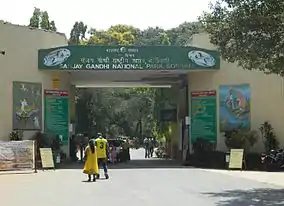 Main gate of the park | |
| Location | Mumbai, Maharastra, India |
| Coordinates | 19°15′N 72°55′E |
| Area | 87 km2 (34 sq mi)[1] |
| Established | 1996 |
| Named for | Sanjay Gandhi |
| Visitors | 2 million (in 2004) |
| Governing body | Ministry of Environment, Forest and Climate Change[2] |
| Website | sgnp |
The rich flora and fauna of Sanjay Gandhi National Park attracts more than 2 million visitors every year. Tourists also enjoy visiting the 2400-year-old Kanheri caves sculpted out of the rocky cliffs which lies within the park.
History
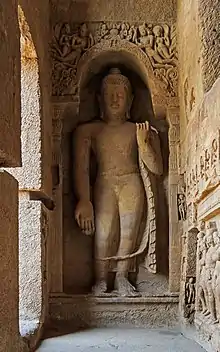
The Sanjay Gandhi National Park area has a long written history dating back to the 4th century BCE. In ancient India, Sopara and Kalyan were two ports in the vicinity that traded with ancient civilisations such as Greece and Mesopotamia. The 45 km (28 mi) land route between these two ports was partially through this forest.[3]
The Kanheri Caves in the centre of the park were an important Buddhist learning centre and pilgrimage site sculpted by Buddhist monks between the 9th and the 1st centuries BCE.[4] They were chiselled out of a massive basaltic rock outcropping.[5]
The Brihanmumbai Municipal Corporation (formerly Bombay Municipal Corporation) acquired the catchment areas of the Tulsi and Vihar lakes, and also added the land from the government dairy of Aarey under protection. The Krishnagiri National Park was established under the Bombay National Park Act in 1942. At that time the area of the park was only 20.26 km2 (7.82 sq mi). The dairy development board began operations near Krishnagiri National Park in 1954, but outside the area of the park. In 1969, 2076 hectares of land of the Aarey Milk Scheme (now known as Aarey Milk Colony) was transferred to the forest department. However, this area was not notified as reserved or protected forests. In 1976, an area of 68.27 km2 was officially designated as Borivali National Park.[6]
The Forest Development Corporation of Maharashtra Limited (FDCM), Nagpur sent an official communication to the Regional Manager, FDCM, Thane on 22 July 1980 stating that the 2076.073 hectares of revenue land that was transferred from Aarey Milk Scheme were to be included in Borivali National Park. The communication also directed that 575 ha of the revenue land should be used to build a recreational zone, while the remaining 1501.073 ha will remain a part of the Borivali National Park. On 10 October 1980, another communication from the FDCM, Nagpur to Thane directed the latter to declare the area as either as reserved or protected forests to allow the department to have stricter legal control. However, no such declaration was made.[6]
The park was further expanded to a total area of 82.25 square km in 1981. The park was renamed Sanjay Gandhi National Park in 1996, after Sanjay Gandhi, the son of former Prime Minister Indira Gandhi. The same year, some forests from the Thane division were merged into the park, further expanding its total area to 103.84 square km.[6]
Geography
The park occupies most of the northern suburbs of Mumbai. To the west lie the suburbs of Goregaon, Malad, Kandivali, Borivali and Dahisar. To the east lie the suburbs of Bhandup and Mulund. To the south lies the Aarey Milk Colony and the university campus of IIT Bombay. The northern reaches of this forest lie in Thane city. The park and these areas surrounding it, except Thane city are all part of Mumbai. It is the only protected forest located within the limits of a city.[7]
The region is hilly with elevations between 30 m (98 ft) and 480 m (1,570 ft). The park has two lakes, Vihar Lake and Tulsi Lake, which meet a part of the city's water requirements. The park is said to be the lungs of the city as it purifies much of the air pollution of the city.
Temperature tends to stay a little lower than the city because of a large green cover. During winters, dense fog can be seen and night temperatures below 15°C is common. Due to its natural green cover and presence of lake and elevation to some extent, rainfall varies greatly as what the city sees. The most southern part of the city (Colaba) receives an average of 2200 mm of rainfall annually, the northern part (Santacruz) receives 2500 mm and the national park, which is just 19 km away from Santacruz, receives more than 3000 mm annually.
During the unusually high rainfall in Mumbai on the 26th of July 2005, Vihar Lake inside the national park recorded 1045 mm in under 18 hours. The nearby Santacruz area received 944 mm while Colaba saw a mere 74 mm of rainfall on the same day. The park receives the highest amount of rainfall in the metropolitan city due to its green cover.
Biodiversity
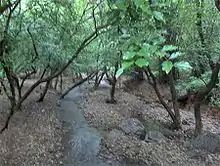
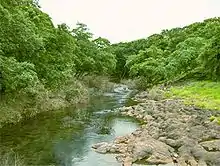
The park is a bustling forest, with an estimated 800 types of mauve. This flower is native to the park and the surrounding regions, including Karnala, the Yeoor hills, Tungareshwar and some parts of Goregaon’s Film City. The park is also home to a small population of leopards.
Wildlife
The park is home to a number of endangered species of flora and fauna. The forest area of the park houses over 1,000 plant species, 251 species of migratory, land and water birds, 5,000 species of insects and 40 species of mammals. In addition, the park also provides shelter to 38 species of reptiles, 9 species of amphibians, 150 species of butterflies and a large variety of fish.[8][9]
Flora
Kadamba, teak, karanj, shisham, and species of acacia, ziziphus, euphorbia, flame of the forest, red silk cotton and a number of other varieties of flowers. Karvi or karvy, a flowering plant that blossoms once in eight years, can be found in the park.
Mass flowering of karvi
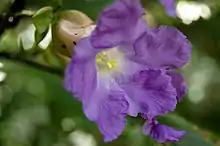
The karvi (or karvy) shrub, as it is locally called in the Marathi language, only blooms once in eight years in a mass flowering covering the forest floor in a lavender blush. It grows in abundance in the Western Ghats hills near Mumbai and throughout the Sanjay Gandhi National Park as in other parts of its natural range. In the Sanjay Gandhi National Park its last blooming occurred in 2016, and it is scheduled to bloom here again in late August-early October 2024. Termed by nature enthusiasts as 'nature's miracle,' the flowers are densest on some of the inner paths and trails that lie undisturbed in the park. It survives best on the vast sloping expanses of the hillsides, with the Kanheri caves area of the park being one of the best places to observe large areas of blooms.[10][11]
In the state of Maharashtra, the mass flowering of karvi has been observed to occur in Mumbai in the same year as in the hill station of Khandala and one year earlier in Bhimashankar and Malshej Ghat, beyond Kalyan.[12] Near Mumbai, the karvi is also found in Karnala, the Yeoor hills, Tungareshwar and some parts of Goregaon including Film City.[11]
Fauna


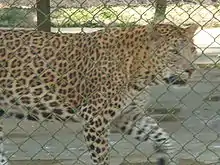
The forest cover in the park helps provide the ideal habitat for many wild animals. Chital (or spotted deer), rhesus macaque and bonnet macaque are some of the wild mammals often spotted inside the park. Other large mammals found in the park include black-naped or Indian hare, muntjac (barking deer), porcupine, Asian palm civet, chevrotain (mouse deer), Hanuman or grey langur, Indian flying fox, sambar deer and leopard. One can also spot striped hyena or four-horned antelope.
Reptiles living here include crocodiles in the Tulsi Lake, pythons, cobras, monitor lizards, Russell's vipers, bamboo pit viper and Ceylonese cat snakes.[8]
In 2003, pugmarks and droppings of a Bengal tiger were found in the park. Although the tiger was never widely sighted, it did bring some excitement to city folks as records of tiger being found here are quite old and forgotten now with the last tiger being shot down 80 years earlier in the region.[13][14][15] Conservation was also proposed for the interlinked habitat corridors and nearby forest areas in the state along with upgrading their status as tiger habitat.[16]
A total 172 species of butterflies have been reported here, of which the spectacular ones are blue Mormon, the phenomenal artist of camouflage, blue oak leaf, bright Jezebel and large yellow and white orange tip, tiger butterfly, eggflies and sailers. There are a number of moths too. The largest moth is the size of a sparrow (30 cm).
Avifauna: Some of the birds found in the park are jungle owlets, golden orioles, racket-tailed drongos, minivets, magpies, robins, hornbills, bulbuls, sunbirds, peacock, and woodpeckers. Migratory and local birds such as paradise flycatcher and various species of kingfishers, mynas, drongos, swifts, gulls, egrets, and herons have also been spotted.[8]
 Leopard at SGNP
Leopard at SGNP Hanuman langur
Hanuman langur Spotted deer in Deer Park
Spotted deer in Deer Park Myna (Acridotheres)
Myna (Acridotheres) Monkeys near Kanheri Caves
Monkeys near Kanheri Caves
Threats
The park has faced a number of problems similar to those faced by national parks elsewhere in the world, involving conflicts between natural and human interests.
In the early 2000s a road, as proposed, would have cut through the park. Animal activist Tarun Nayar went to court to halt this project.
The lack of space in Mumbai has pushed residential colonies right up to the park boundary. This boundary is poorly fenced and wild animals often wander into human habitations. Slums have mushroomed around the park as well. Corruption among local politicians and Mumbai's influential builder lobby are commonly seen as responsible for a perceived shrinking of the park.
In June 2004, leopards were responsible for the deaths of 20 humans within the span of a week. This was not the first attack: for the past 10 years, there have been attacks attributed to leopards stalking children and adults outside the park fringes. After an outcry was raised and the situation reached alarming proportions, eight leopards were caught and relocated.
The leopard threat still continues in and around Thane district today with repeated sightings as well as attacks on pets and humans. On 16 July 2012, a seven-year-old girl was killed in Mulund right outside her home by a leopard. A year later, a 40-year-old woman was attacked and killed by a leopard in Bhiwandi, Thane City in 2013. Five days later, a 14-year-old shepherd survived a leopard attack in the same region.[17] In 2014, a two-year-old child went missing from Ghoong village in Wada.[18] August 2015 saw four leopard attacks in Thane city.[19] In one incident, a leopard and her cub dragged a one-year-old Rottweiler off.[20]
Poaching
Unfortunately, Sanjay Gandhi National Park has seen many poachers in recent years. Usually, leopards are attacked. In many cases, these animals had been poisoned, and claws or other valuable body parts were cut off and sold. Poaching could soon wipe out Mumbai's leopard population.
Fire
During the summer and any time before the monsoon, fires burn in the park, at least once every two weeks. This has resulted in the loss of rare trees and the loss of habitat for wild animals. The locals are often suspected of burning the trees on some of the outskirts of the forest to build their homes there.
Tourism
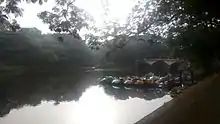

Sanjay Gandhi National Park is said to be one of the most visited national parks in Asia. According to estimates, around 2 million visitors visit this park annually. Collection at the gates in November 2004 touched ₹9.8 million (US$140,000).
The Krishnagiri Upavan is an area of approximately 5.5 km2 (2.12 sq mi) reserved as an easily accessible public recreation zone inside the park, while access to the remaining area is restricted. Among the several attractions of the Krishnagiri Upavan is a mini-zoo, a crocodile park and the lion and tiger safaris through the natural habitats of these animals. A narrow-gauge train travels around the tourist zone showcasing parts of the forest's rich biodiversity. Boating facilities such as two-person, pedal-powered boats are available for a nominal fee. Two watchtowers afford panoramic views of the park.

Hundreds of thousands of visitors travel to the Kanheri Caves, especially during festivals such as Maha Shivaratri. Nature trails and treks are also popular. Rock climbing enthusiasts often visit the national park as the numerous rock faces there and at the Kanheri Caves offer a great opportunity for rock climbers. The national park witnesses thousands of morning walkers every day, like the elderly, the youth, and children visit it for a breath of fresh air. It is also an abode for sports lovers who can be seen practicing cricket, badminton, and even marathons among other sports. Regulars opt for a nominal annual fee, and senior citizens are offered discounted rates. There are many smaller parks within the national park with flower gardens, mini-waterfalls, resting spots, sunrise/sunset views, the occasional deer and the misty boating lake.
 SGNP view from Highest Point Trail
SGNP view from Highest Point Trail Mini waterfall inside a park within national park premise
Mini waterfall inside a park within national park premise Villages in the park
Villages in the park Mahatma Gandhi Memorial
Mahatma Gandhi Memorial
Van Rani narrow gauge train

The park also features a "toy train" that runs on a narrow gauge railway. Named Van Rani, which means "jungle queen," it was operational for about twenty-five years before it was discontinued in 2001 because of the poor condition of the track. The circuitous route covers a 2.5 km (1.55 mi) distance. However, in 2004, fresh bids were announced for the repair of the track, which was estimated to cost around ₹3 million (equivalent to ₹8.6 million or US$120,000 in 2019). The tracks were repaired and the train was restarted. It offers a 15-minute ride along the foothills of the Mahatma Gandhi Memorial at 190 m (620 ft) Pavilion Hill traverses a couple of bridges and tunnels, and passes over the Deer Park.
Boating
Boating services are available near the Van Rani starting point with 2- and 4-seater pedalos for sailing in the small lake, which has a view bridge where visitors can stand and watch the boats in the water.
Tiger and lion safaris

Main attractions of the park are lion and tiger safaris for encouraging eco-tourism.[21] The lion safari is a 20-minute ride through a 12 ha (29.65 acres) fenced forest area in one of the park's green buses. The park is home to an estimated 25 lions and lionesses, of which only 2 can be safely seen at close range from the caged buses. The remaining 23 have been relocated or placed in fenced areas far away from the roads used by the green buses. During visiting hours, some of the resident lions are let out into the enclosure and can be viewed from the safety of the bus. There are 4 tigers that are kept semi-confined in a 20 ha (49.42 acres) fenced area that is toured by the buses. A 5 m (16.40 ft) high and 2,200 m (7,217.85 ft) long protective fencing surrounds the area. This is done so that all visitors can safely view lions and tigers in their natural habitat.[22] Here the visitors are caged in the bus so the big cats can roam like in the wild. Two other tigers roam in a much larger area. There are many claims that these tigers and lions are tranquilized in the interests of tourism.
Walking trails
There is a number of public walking trails in the national park. The popular Ashok Van trail winds through thick forest to a dense cluster of Ashoka trees that are a welcome halfway resting spot. The return journey is usually via the Gaumukh trail that leads to an open volcanic rock face and ends at the Kanheri caves. A more challenging route is called the 'View Point' trail and leads to the highest point in Mumbai, which affords a panoramic view of the city and its three lakes – Tulsi Lake, Vihar Lake and Powai Lake. New jungle trails at Sanjay Gandhi National Park allow visitors to see the more unexplored parts of the park for a nominal fee. They are the 4 km (2.49 mi) Shilonda Trail, the 5 km (3.11 mi) Malad Trail, and the 6 km (3.73 mi) Yeoor Trail.[23]
Local conservation NGOs such as the Bombay Natural History Society (BNHS)[11] and World Wide Fund for Nature - India (WWF-India)[12] bring groups of urban residents from Mumbai and elsewhere, sometimes in collaboration with other organisations, for regular guided nature education walks in the nature trails of Sanjay Gandhi National Park[24][25] and organise special trips when the rare karvi flowers are in full bloom which only happens once every eight years.[10]
Jain temple
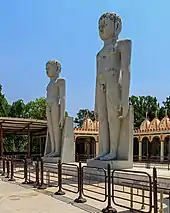
- Trimurti Temple
In the forest, there is a famous Jain temple called Trimurti (meaning "three idols") or Trimurti Digambar Jain Mandir. This temple is widely visited by Digambar sect of the Jain community. It has three huge idols of Lord Adinath and his two sons, Lord Bahubali and Lord Bharata. The statue of Rishabhanatha is 31 feet in height and the tallest off all the three; on either side are the statues of Bharata and Bahubali, each being 28 feet tall. There is a 51-foot kirti stambh (literally meaning "pillar of glory") also present here.[26] Many muni maharaj (Jain saints) often stay here and preach to their followers before moving on.
Kanheri caves
The Kanheri Caves are a protected archaeological site at 19°12′30″N 72°54′23″E. The caves were sculpted by Buddhist residents around the 1st century BCE. The area was a settlement that once served as inns for travelers. The word Kanheri comes from the Sanskrit word Krishnagiri which means "black mountain".
- Buddhist Viharas
Seven Buddhist caves older than Kanheri Caves have also been discovered very recently. Detailed exploration and documentation is awaited from The Archaeological Survey of India.[27]
 Vihara prayer hall, one of the larger Kanheri caves
Vihara prayer hall, one of the larger Kanheri caves Buddhist caves at Kanheri
Buddhist caves at Kanheri
Access
The park's main entrance is located in the northern Mumbai suburb of Borivali, 0.9 km (0.56 mi) east of Borivali railway station, which is connected by road and rail to Mumbai and Maharashtra. The Western Express Highway (NH 8) passes by the park entrance. Buses are available on holidays and Sundays from Mumbai to the park. Also, chartered vehicles can be hired for groups to visit the park.
The park can also be accessed from Goregaon (BNHS, Film City).
The park is accessible from eastern side as well, through Mulund (Vasant Garden) and through Thane from two locations - Yeoor and Tikuji-Ni-Wadi, near the Nature Center.
The nearest airport is Chhatrapati Shivaji International Airport at Santa Cruz 18 km (11 mi) from the park. Nearest railway stations are Borivali and Goregaon on Western line (Mumbai Suburban Railway), which are connected to Churchgate railway station & also Mulund and Thane on the Central line (Mumbai Suburban Railway), which are connected to Chhatrapati Shivaji Terminus.
Park hours
The main gates open at 7.30 a.m. and close at 5.30 p.m. The park also provides monthly and yearly passes for morning walks. The access timing for pass-holders is 5.00 a.m. to 7.30 a.m. only and personal transport vehicles are allowed within the park till the Kanheri Caves by paying a nominal amount at the main gate.
References
- Narkar, N.S.; Mhaiske, V.M.; Patil, V.K.; Narkhede, S.S. and Malave, D.B. (2017). "Socio-Economic Impact of Tourism Activity on Local Stakeholders of Sanjay Gandhi National Park, Borivali, Mumbai". Journal of Tree Sciences. 36 (2): 105−114. doi:10.5958/2455-7129.2017.00032.2.CS1 maint: multiple names: authors list (link)
- "Presentation".
- "Historical Information". Sanjay Gandhi National Park. Sanjaygandhinationalpark.net. Archived from the original on 8 April 2010. Retrieved 30 January 2010.
- "Kanheri Caves". Archived from the original on 12 May 2001. Retrieved 28 January 2007.
- "Mumbai's Ancient Kanheri Caves". Retrieved 31 January 2007.
- "Metro-3 row: 1,501 hectares of Aarey Milk Colony is part of Borivli national park in Mumbai, say experts". Hindustan Times. 20 February 2017. Retrieved 20 February 2017.
- "Mumbai's Sanjay Gandhi National Park: Essential Visitor's Guide". TripSavvy. Retrieved 12 June 2019.
- "Sanjay Gandhi National Park, Borivali, Mumbai". Wildlife/National Parks. Maharashtra State Forest Department. Archived from the original on 10 February 2010. Retrieved 28 January 2010.
- Mirza, Zeeshan. & Pal, Saunak. (2008) A checklist of reptiles and amphibians of Sanjay Gandhi National Park, Mumbai, Maharashtra. Cobra, II (4), 14–19.
- Nature lovers on the Karvy trail; TNN, 22 September 2008; The Times of India
- City gears for lavender Karvi’s once-in-eight-years bloom Archived 17 August 2008 at the Wayback Machine; by Nitya Kaushik; 12 August 2008; The Indian Express Newspaper
- The Karvy blooms; By Shantanu Chhaya; 24 July 2000; Bombay Edition: Bombay Times; The Times of India Supplement. A copy of this original Newspaper article is posted online at "mumbai-central.com": Archived 6 April 2010 at the Wayback Machine
- "Mumbai leaps into tiger territory".
- Livemint. "A tiger on Malabar Hill". www.livemint.com. Retrieved 18 March 2018.
- "The Hindu : Book Review : India's natural history".
- "Archived copy". Archived from the original on 3 January 2013. Retrieved 17 December 2009.CS1 maint: archived copy as title (link)
- "Teen injured in leopard attack in Thane". 31 July 2012. Retrieved 18 March 2018 – via www.thehindu.com.
- "Leopard attack: 50 men search for 5 days but can t find 2-yr-old s body". mid-day.com. 1 September 2014. Retrieved 18 March 2018.
- "4 leopard attacks in 2 months leave Ovala residents on edge - Times of India". indiatimes.com. Retrieved 18 March 2018.
- Mishra, Rashmi (12 August 2015). "Leopard Attack in Thane: Female Leopard & cub caught on CCTV snatching pet Rottweiler dog". india.com. Retrieved 18 March 2018.
- To spot the Bengal tigers, visit Borivali National Park; by Nitya Kaushik; May 16, 2008; The Indian Express Newspaper Archived 2 October 2012 at the Wayback Machine
- "Sanjay Gandhi National Park Safari". maharashtratourism.net. Retrieved 28 January 2010.
- Cook, Sharell (10 January 2009). "New Nature Trails at Sanjay Gandhi National Park in Mumbai". About.com:India Travel. Retrieved 28 January 2010.
- "Wet and Wild - Indian Express". www.indianexpress.com. Retrieved 18 March 2018.
- BNHS~ WWF to prevent garbage at Borivali park; 11 March 2002; Mid-DAY Newspaper
- "Archived copy". Archived from the original on 3 October 2016. Retrieved 23 July 2016.CS1 maint: archived copy as title (link)
- "Seven ancient Buddhist caves found in Mumbai". The Times of India. Bennett, Coleman & Co. Ltd. 17 January 2016. Retrieved 17 January 2016.
Sources
Parts of the article referred to from the Times of India article dated 5 July 2004
- Amol Patwardhan (2014) Butterflies of Sanjay Gandhi National Park, Mumbai, Maharashtra, India, Ambient Science, 1(1): 7-15.
- Sanjay Gandhi National Park: Flickr Group photos
Kasambe, R. (2012): Butterfly fauna of the Sanjay Gandhi National Park and Mumbai. Bionotes. 14 (3): 76–80
External links
| Wikimedia Commons has media related to Sanjay Gandhi National Park. |
- Official website
- SGNP link on Maharashtra FD Website of "Sanjay Gandhi National Park Borivali, Mumbai 400066".
- A detailed Review of Kanheri Caves and : Read this before you go.